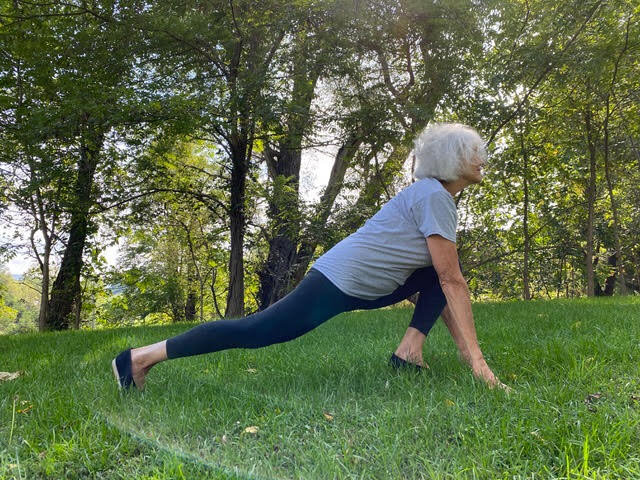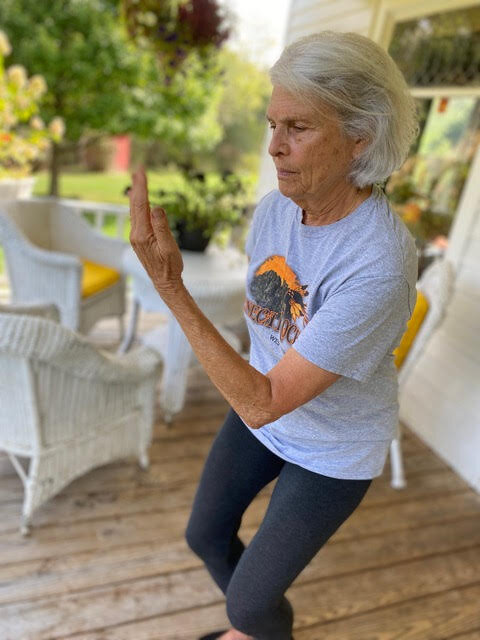


A lifetime of twists and turns have led me to this moment of sharing the art of qigong with my community as a teacher. Here is my story — I look forward to learning yours.
I cannot completely answer why the Chinese language and China have such a hold on me, but they do. They always have. Growing up in San Francisco, I would spend hours roaming through Chinatown, captivated by the sounds and smells of the dim sum tea shops and the grocery stores selling fresh and dried products of the land and sea. During my undergraduate studies at University of California at Berkeley, I majored in Asian history while beginning what would become a lifelong study of Mandarin Chinese. I was lucky enough to be in the last basic language class of a world-renowned Chinese linguist, Chao Yen Ren, before he retired from teaching. Among other achievements, he left an indelible mark on our culinary language when he coined the terms “stir-fry” and “pot sticker” while translating his wife’s Chinese cookbook.
After graduating in 1964, I moved to Thailand with the Peace Corps because it was as close to China as I could get at the time. Following my two years of service, I moved to Taiwan, the only “China” recognized by our country, to continue learning Chinese. In Taipei, I was able to live with a Chinese family and continue studying while I supported myself teaching English. Now I could roam (and listen and smell) through an entire Chinese city instead of just a Chinatown neighborhood. After some more adventures across various Asian countries, my fascination with China remained strong, but I returned to the United States in 1970, got married, had three children, got a master’s degree in social work, and eventually started a psychotherapy practice.
My life was full, yet something was missing. As I contemplated turning 50 and the fact that there was less of my life ahead of me than behind that awakened an ache to return to Thailand. It was hard to believe I’d actually lived there. I spent a year polishing my rusty Thai with monks at a Thai temple and then had a magical visit to my Peace Corps town with my husband and teenage children.
Yet China still loomed in my dreams. At the time, it never occurred to me to visit Mainland China. Plus I was preoccupied with my life and my clients. If I looked back at China at all, it was like looking down the wrong end of a telescope: instead of the language and culture of China appearing closer and sharper, they were tiny and at an immeasurable distance away. That was the early 1990s, and it had been barely a decade since China began recovering from the Cultural Revolution, launching the economic freedoms we take for granted today, allowing Chinese students to study abroad, and welcoming foreigners to visit.
Then, suddenly, 70 loomed. There are several choices a person could make at 70: some can’t wait to retire from a lifelong profession and travel, paint, and more. Others see an ending: Carolyn Heilbrun, a Columbia history professor, declared that she would end her life at that “biblical three score and ten.” I had no intention of following either of those paths. Instead, I chose to commit to the path I’d been traveling one way or another my entire life — I would go to China.
My first step was awakening at 68 years old my long-dormant study of written and spoken Chinese. After two years I had enough command of the language to take my first trip. I discovered on my first trip that my inner Peace Corps volunteer was as vibrant as ever: traveling in Yunnan Province, taking buses, making new friends, and feeling very much at home. On a second trip a year later, I took my husband to a few places I wanted to revisit and then headed off alone to fulfill another Chinese dream: learn tai-chi. I found a traditional school in beautiful karst-studded Yangshuo in Guangxi Province where Master Wu Ping introduced me to Yang-style tai-chi and the transformational practice of qigong.
Those of us in the West are more familiar with the term “tai-chi” than “qigong.” Despite my fascination with all things Chinese, I’d never heard of qigong before. I’ve since come to appreciate it as an important foundation of tai chi. I practice a qigong routine as soon as I stumble out of bed in the morning and then I am able to practice a tai chi routine. Just as a cup of warm water helps to cleanse my system after sleeping, or a good stretch prepares you for a workout, so does a qigong routine wake up my ligaments and tendons that have contracted during sleep..
When I returned home to Washington, DC, I found a wonderful tai-chi group led by Master Nick Gracenin and continued learning. On a third trip to China with a friend, we returned to Master Ping’s school where we were introduced to Chen style tai-chi. We were even able to perform tai-chi with our Washington, DC, tai-chi group in Beijing to honor a revered tai-chi master on his 80th birthday.
My path had taken me from wandering San Francisco’s streets as a child to performing in a Beijing university’s theater in my mid-70s. I didn’t plan it all in advance, but somehow it all made sense.
Fast forward to March 2020 and the start of the worldwide Covid-19 pandemic. How could I continue my study and practice of qigong and tai-chi? Through the miracle of Zoom, I maintained my learning with both my teachers: Master Wu Ping in China and Master Nick Gracenin in Washington, DC!
And now, I want to share some of the gifts I have received from these two masters starting with qigong. As a lifelong learner, I’m also prone to wanting to teach what I have learned. When I learned to make sushi and Vietnamese garden rolls I couldn’t help teaching my kids and friends. I’m even continuing to teach English to a Chinese friend. So here I am launching a website to teach qigong.
It’s the next step on my path — perhaps it can be the first of yours. Welcome! Let’s start learning qigong together!